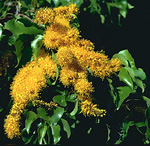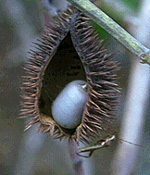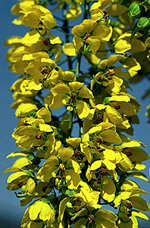 |
A large family from the tropics and subtropics of all continents, many
species of Caesalpiniaceae occur in Australia, mostly in northern monsoon
forests and rain forests and in arid and semi-arid shrublands (esp. Senna).
They are rare in the cooler temperate parts of the south-east and south-west,
and are absent from the alps and Tasmania.
Characteristic features of the family Caesalpiniaceae in Australia include: - trees, shrubs or rarely herbs, usually with pinnate or bipinnate leaves
- flowers in racemes or occasionally solitary, slightly zygomorphic, usually cream or yellow, more rarely pink or red
- petals usually 5, free, often with darker basal blotches
- stamens 10 or fewer, often with large anthers
- ovary superior, narrow, maturing into a pod
Description
Evergreen trees, shrubs or perennial terrestrial herbs. Stems unarmed or rarely with prickles or spines arising from the stem surface. Vegetative reproduction uncertain. Extra-floral nectaries absent or present on the foliage. Internal secretions not obvious or of resin. Plants glabrous or with simple, glandular or non-glandular, unicellular or uniseriate hairs. Leaves mostly well developed or rarely much reduced, alternate and spiral, cauline if herbs, petiolate, subsessile or sessile; pulvinae present. Stipules absent or present, distinct and free from the petiole, scale-like, membranous or bristle-like, falling off early; stipellae present or absent. Lamina simple, once compound or bicompound, unifoliolate, bifoliolate, paripinnate or imparipinnate, symmetric or conspicuously asymmetric; lamina/leaflets filiform, acicular, subulate, linear, lanceolate, ovate, elliptic, oblanceolate, obovate or oblong; base cuneate, attenuate, rounded or oblique; margins entire, ±flat; one-veined, or the venation pinnate, with the midrib conspicuous, and the tertiary venation not reticulate; surfaces not punctate; herbaceous. Male and female flowers occurring on separate plants, or bisexual flowers and male flowers occurring on some plants and bisexual flowers and female flowers on others, or with the all the flowers bisexual. Inflorescences terminal or axillary, consisting of spikes, racemes or cymes. Bracts present. Bracteoles present or absent. Pollination by insects and ?birds. Flowers odourless or fragrant; sessile or stalked. Floral disc absent; nectaries present on the carpels. Perianth of 2 dissimilar whorls or of 1 whorl only or all whorls ±similar. Calyx regular or slightly irregular; segments free or fused, with 3–5 sepals or lobes, imbricate or valvate in bud; calyx bell-shaped, herbaceous. Corolla regular or irregular; segments free, with (0–) 5 petals, alternating with the sepals or calyx lobes, imbricate in bud; corolla 1-lipped, cream, yellow, red or pink, without contrasting markings, or streaked, spotted, etc, membranous; claws present; lobes ±entire. Fertile stamens 3, 7 or 10, not clearly correlated with the sepals or calyx lobes, free of the corolla, free of the ovary and style, distinct from each other or fused by their filaments into an open or closed tube, all ±equal. Staminodes present or absent. Anthers basifixed, versatile or not versatile, opening sideways or inwards by pores or by longitudinal slits; 2-celled. Ovary superior and sessile. Carpel 1; ovary with 1 locule. Style terminal, single and unbranched. Ovules 2–numerous, stalked; placentation parietal. Fruit dry or fleshy, dehiscent or rarely indehiscent, a septicidal legume sometimes with explosive dehiscence, or rarely a camara or a drupe; the perianth on the maturing fruit deciduous. Disseminule macro-surface featureless, winged, costate or with spines; micro-surface ±smooth or reticulate, brown or black, glossy or dull. Seeds 2–numerous per fruit. Aril present or absent. Cotyledons 2. Embryo straight or curved.
(Note: this description has been generated from the coded data compiled for the key. Any errors in the key data will be reflected in the descriptions.)
A treatment of the family Caesalpiniaceae has been published in:
Flora of Australia 12: 50-178.
Australian genera of Caesalpiniaceae (as recognised for the Flora of Australia)
† = some species native, others introduced
* = all species introduced
Barklya
Bauhinia
Caesalpinia
Cassia
*Ceratonia
Chamaecrista
Crudia
Cynometra
*Delonix
Erythrophleum
*Gleditsia
Intsia
Labichea
Lysiphyllum
Maniltoa
*Parkinsonia
Peltophorum
Petalostylis
Piliostigma
†Senna
Sindora
Storckiella
*Tamarindus

|
  |

Barklya syringifolia (flowers)
Photo: H.Nicholson © H. & N. Nicholson

Bauhinia hookeri (flowers)
Photo: H.Nicholson © H. & N. Nicholson

Caesalpinia bonduc (fruit)
Photo: H.Nicholson © H. & N. Nicholson

Cassia brewsteri var. marksiana (flowers)
Photo: H.Nicholson © H. & N. Nicholson

|
 |
|